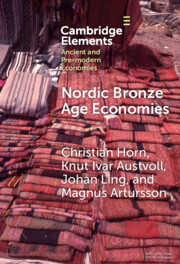Refine search
Actions for selected content:
26946 results in Economic history
Introduction
-
- Book:
- Making Mao's Steelworks
- Published online:
- 19 December 2024
- Print publication:
- 05 December 2024, pp 1-26
-
- Chapter
- Export citation
5 - Who Owns the State-Owned Enterprise?
- from Part II - Socialist Industrialization as a Hybrid System, 1948–1957
-
- Book:
- Making Mao's Steelworks
- Published online:
- 19 December 2024
- Print publication:
- 05 December 2024, pp 163-192
-
- Chapter
- Export citation
Part II - Socialist Industrialization as a Hybrid System, 1948–1957
-
- Book:
- Making Mao's Steelworks
- Published online:
- 19 December 2024
- Print publication:
- 05 December 2024, pp 99-226
-
- Chapter
- Export citation
4 - Machetes, Axes, and Foreign Tools
-
- Book:
- Plebeian Consumers
- Published online:
- 18 December 2024
- Print publication:
- 05 December 2024, pp 118-150
-
- Chapter
- Export citation
3 - Zarazas, Bayetas, and Bogotanas
-
- Book:
- Plebeian Consumers
- Published online:
- 18 December 2024
- Print publication:
- 05 December 2024, pp 83-117
-
- Chapter
- Export citation
Preface
-
- Book:
- Making Mao's Steelworks
- Published online:
- 19 December 2024
- Print publication:
- 05 December 2024, pp xii-xii
-
- Chapter
- Export citation
Figures
-
- Book:
- Plebeian Consumers
- Published online:
- 18 December 2024
- Print publication:
- 05 December 2024, pp ix-x
-
- Chapter
- Export citation
Part I - Empire, War, and the Global Crisis of Capitalism, 1915–1948
-
- Book:
- Making Mao's Steelworks
- Published online:
- 19 December 2024
- Print publication:
- 05 December 2024, pp 27-98
-
- Chapter
- Export citation
Contents
-
- Book:
- Making Mao's Steelworks
- Published online:
- 19 December 2024
- Print publication:
- 05 December 2024, pp v-vii
-
- Chapter
- Export citation
Contents
-
- Book:
- Plebeian Consumers
- Published online:
- 18 December 2024
- Print publication:
- 05 December 2024, pp vii-viii
-
- Chapter
- Export citation
Conclusion
-
- Book:
- Making Mao's Steelworks
- Published online:
- 19 December 2024
- Print publication:
- 05 December 2024, pp 294-304
-
- Chapter
- Export citation
Acknowledgments
-
- Book:
- Making Mao's Steelworks
- Published online:
- 19 December 2024
- Print publication:
- 05 December 2024, pp 305-310
-
- Chapter
- Export citation

Nordic Bronze Age Economies
-
- Published online:
- 03 December 2024
- Print publication:
- 19 December 2024
-
- Element
-
- You have access
- Open access
- HTML
- Export citation
BHR volume 98 issue 4 Cover and Back matter
-
- Journal:
- Business History Review / Volume 98 / Issue 4 / Winter 2024
- Published online by Cambridge University Press:
- 14 April 2025, pp. b1-b6
- Print publication:
- Winter 2024
-
- Article
-
- You have access
- Export citation
RHE series 2 volume 42 issue 3 Cover and Back matter
-
- Journal:
- Revista de Historia Economica - Journal of Iberian and Latin American Economic History / Volume 42 / Issue 3 / December 2024
- Published online by Cambridge University Press:
- 05 March 2025, pp. b1-b2
- Print publication:
- December 2024
-
- Article
-
- You have access
- Export citation
China’s Outward Investment in Europe during the “Go Out” Policy Years: Trends, Drivers, and Strategies in the Automotive Industry, 2000–2018
-
- Journal:
- Business History Review / Volume 98 / Issue 4 / Winter 2024
- Published online by Cambridge University Press:
- 12 February 2025, pp. 821-853
- Print publication:
- Winter 2024
-
- Article
-
- You have access
- HTML
- Export citation
Announcements
-
- Journal:
- Business History Review / Volume 98 / Issue 4 / Winter 2024
- Published online by Cambridge University Press:
- 14 April 2025, pp. 953-957
- Print publication:
- Winter 2024
-
- Article
-
- You have access
- HTML
- Export citation
Paths of Fire, The Gun and the World It Made. By Andrew Nahum. London: Reaktion Books, Ltd, 2021. 253 pp. Hardcover, £25. ISBN: 978-1-78914-397-3.
-
- Journal:
- Business History Review / Volume 98 / Issue 4 / Winter 2024
- Published online by Cambridge University Press:
- 14 April 2025, pp. 981-983
- Print publication:
- Winter 2024
-
- Article
- Export citation
Editors’ Note
-
- Journal:
- Business History Review / Volume 98 / Issue 4 / Winter 2024
- Published online by Cambridge University Press:
- 14 April 2025, p. 791
- Print publication:
- Winter 2024
-
- Article
-
- You have access
- HTML
- Export citation
Precios de la energía y transición energética en Chile, 1841–1970
-
- Journal:
- Revista de Historia Economica - Journal of Iberian and Latin American Economic History / Volume 42 / Issue 3 / December 2024
- Published online by Cambridge University Press:
- 05 March 2025, pp. 331-354
- Print publication:
- December 2024
-
- Article
- Export citation
